9+ Product Marketing Plan Examples to Download
Marketing is the path that brings customers to your products. When running a business, one of the things that you need to prioritize is the way you market your goods to prospective customers and loyal fans. You may also see strategic marketing plan examples.
New Product Marketing Plan Template
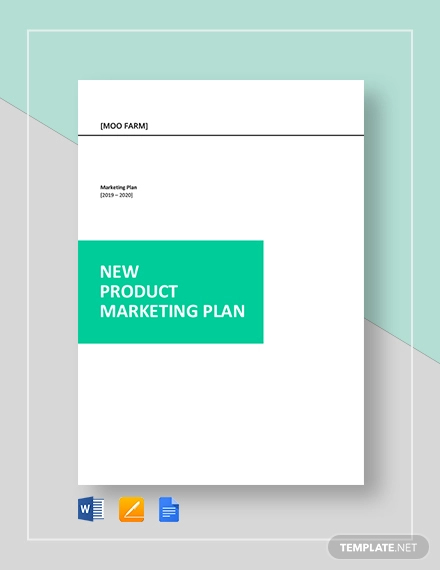
Product marketing allows you to pay attention to the needs and problems that your customers have, that you can solve with your products. By identifying the right product and getting it to those who may need it, your company can drive sales and profits with these goods. In an extremely competitive industry, product marketing might as well be your key to business success. You may also like define marketing plan and its purpose?
Free Product Marketing Plan Example
Manufacturing Product Marketing Plan Example
Product Marketing Launch Plan Example
What Does Product Marketing Do?
While every sector of the company focuses on what’s best for its customers, product marketing puts customers at the front and center of everything it works for. We all know that the primary goals of traditional marketing include building brand awareness, expanding to new markets, and even strategic communication. But when it comes to product marketing, the focus is solely given to the satisfaction of its existing customers. You may also see how to create an executive summary of a marketing plan.
To do this, you need to develop a deeper understanding of who your audience is, what they want, what influences their buying decisions, what problems need to be solved, and what their perceptions are toward your proposed solutions.
Though it may seem as though people come to your store to buy your products, they are actually buying solutions to their problem. With that being said, knowing their problem allows you to develop and promote the best solution to such problem. You may also like digital marketing plan examples.
Effective Ways to Market a Product
Marketing a product works in various ways. Everything from the product’s packaging, features, pricing, and promotion plays a key role in its success. You may not have a billion dollars to throw at your advertising strategies, but you can surely use the principles and techniques that formulate a winning campaign. You may also check out restaurant marketing plan examples.
Here are some awesome secrets in product marketing you might want to apply:
1. Tell a story.
Again, it’s time you start eliminating those self-centered thoughts and realize that no one wants your products, they just need a solution to their problem.
So instead of concentrating on benefits, features, and facts, the real game changer is telling a (true) story. Stimulating one’s emotions through storytelling can help make your advertisement memorable. A real-life story can easily capture a viewer’s attention, and keep them connected to your product and brand. You might be interested in event marketing plan examples.
2. Don’t work against your image.
Many product marketing campaigns fail not because their products aren’t good, but because the company responsible for producing these products forget how important consumer perception is. For instance, in the 1980s, the candy brand Life Savers marketed their own soda line in an attempt to widen their audience. Although the soda did pretty well in taste tests, it tanked among buying customers.
People assumed that the drink was purely made up of liquid candy, and it comes as no surprise considering the image the brand has already established for itself.
3. Do what your competitors won’t dare to do.
Taking risks in a fast-changing world is a bold move. But sometimes, taking the leap can lead to successful outcomes.
Around the 1970s to the 1980s, Nike used a marketing tactic that was sometimes scoffed at in the advertising world: celebrity athlete endorsements. The sports apparel company began signing well-known and up and coming athletes for their product marketing campaign. Instead of playing it safe, Nike decided to try something new despite the high chances of failing. You may also see personal marketing plan examples.
4. Market to existing customers.
When brands like Pepsi and Coke began to dominate the beverage market in the early 1990s, there was an alarming decline on milk consumption in California.
Apparently, there was nothing exciting about milk that made people want to buy them. This forced the California Advisory Board to work with GS&P to find how they could increase milk sales. This led to the creation of the popular Got Milk? campaign which helped increase the demand among loyal fans. You may also like making marketing plans that work.
5. Introduce new products with new brand names.
You may not know it, but some of the biggest companies in the world carry a series of brands under their wing that each focuses on a niche market.
Let’s take Procter & Gamble as an example. P&G has generated more than a billion dollars from their brands Ariel, Crest, Gillette, Olay, Head & Shoulders, Oral-B, Pampers, Pantene, and Tide, just to name a few. P&G has a total of 55 product lines that cater to a variety of customer needs and demands. You may also check out integrated marketing plan examples.
Product Marketing Plan Guidelines Example
Product Marketing Plan Outline Example
Product Marketing Plan Proposal Example
Popular Brands with Successful Product Marketing Plans
Companies that market their products beyond consumer expectations are usually the most successful. Not only because they influenced the growth of the brand, but also because of how they managed to speak the universal truth that customers continue to remember years after these campaigns were first launched. You may also see how to write a marketing plan for a business.
The following are examples of some of the best product advertisements of all time, along with the lessons we can learn from them:
1. Coca-Cola: Share a Coke
While everyone was too busy trying to appeal to the masses, Coca-Cola focused on individuality—simply by putting a person’s name on each of their bottles.
The #ShareACoke campaign was a huge hit on social media, with everyone posting photos of a coke bottle with their names on it.
The campaign began in Australia in 2011 when the company decided to print personalized bottles with 150 of the most popular names around the country. The company even allowed customers to order custom bottles from their website with requests that include nicknames and college logos. For some wild reason, many people were entranced by the campaign despite knowing that the personalized item was only temporary. You may also like marketing strategy plan examples.
2. Volkswagen: Think Small
Volkswagen’s product marketing campaign focused on one vital question: how can you change one’s perception not only about a product but also about an entire group of people?
The company’s Think Small campaign wanted to prove something to its foreign audience. You see, Americans were stern on buying big American cars, and 15 years after WWII ended, there was still no interest in small German cars due to the circumstance at hand. You may also check out apartment marketing plan examples.
So rather than trying to be something they’re not, Volkswagen decided to swing it with an ad campaign that screams, “You think I’m small? Yeah, I am.” Consumers immediately caught on to the campaign because of its sincerity and honesty.
3. Apple: Get a Mac
Apple has always been pretty good with their product marketing campaigns, but the Mac vs. PC debate has to be one of their most successful campaigns of all time. It was simple, clever, and most of all—brutally honest. The commercial tells viewers everything they need to know about a Mac in a witty yet creative way. This created a connection between the brand and its consumers, allowing people to see themselves using it.
4. Wendy’s: Where’s the Beef?
Wendy’s had the guts to take on their competitors without going as far as name dropping their targets. Instead, the company pointed out the lack of beef in competitor’s burgers through a Where’s the Beef? marketing campaign. Even though the campaign only ran for a year, the catchphrase managed to leave a mark in the minds of consumers. You might be interested in advertising plan examples.
5. Procter & Gamble: Thank You, Mom
Probably one of the most sentimental product marketing campaigns to ever hit the small screen, Procter & Gamble developed a commercial that gave viewers a glimpse of the love and sacrifice that mothers of Olympic athletes had to endure. It was an ad that pulled at the heartstrings of viewers through its timely and relatable approach that consumers are sure to remember for a very long time. You may also see email marketing plan examples.
Product Marketing Plan Template
Simple Product Marketing Plan Example
Small Business Product Marketing Plan Example
How to Create a Product Marketing Plan
A written marketing plan can function as a guide for you to follow in order to accomplish your goals for product marketing. The business owner or marketing manager is usually held responsible for putting together a plan, but regular employees, such as a finance manager or an operations manager, can also provide valuable input for the plan to work.
To help you through this process, here’s a step-by-step guide for you to follow:
1. Define your product and sales goals.
Create a description for the product you’re marketing. But as opposed to focusing on its mere features (size, color, style), describe how the product may benefit its users. You should also identify your desired professional goals for the product, along with a deadline or time frame for the specified goal.
2. Formulate a market analysis.
Create a SWOT analysis for your product marketing plan. This includes the strengths and weaknesses that exist within your company and the product, as well as the opportunities and threats in the external environment that may impact your product sales. This analysis will help you determine the difference of your product from its competition, allowing you to make the most out of this uniqueness by developing a distinct marketing message.
3. Describe your target market.
Your target market is composed of the individuals or groups that use your product or who would likely benefit from your products the most. In this section of your plan, you must provide specific information about your market segment. This includes their age, gender, geographic location, household income, and work situation. You may also see daily plan examples.
4. Develop marketing strategies.
Now that you have established your marketing goals and identified your target market, you can now formulate your strategies. Marketing strategies involve the specific steps you’re willing to take in order to promote the product. This should describe how the product is promoted, distributed, priced, and packaged before it reaches the hands of its consumers.
5. Determine the marketing budget.
Naturally, you won’t be able to launch a campaign without a budget to start with. Budgets are usually defined during the start of the year, so with the money that has been allocated to your department, decide how much of it will be used to market and promote the given product. This will help you determine which marketing strategies may be executed according to the allotted budget.
It’s hard to accomplish anything without a general plan in place. Plans help us make strategic decisions based on market research and analysis. And if a company decides to introduce a new product to its consumer market, they must first develop a plan to minimize the likelihood of errors and poor decisions. As the fast-changing market continues to grow, so does the strategies to which these products are marketed to the public.
9+ Product Marketing Plan Examples to Download

Marketing is the path that brings customers to your products. When running a business, one of the things that you need to prioritize is the way you market your goods to prospective customers and loyal fans. You may also see strategic marketing plan examples.
New Product Marketing Plan Template

Details
File Format
Google Docs
MS Word
Pages
Size: US, A4
Product marketing allows you to pay attention to the needs and problems that your customers have, that you can solve with your products. By identifying the right product and getting it to those who may need it, your company can drive sales and profits with these goods. In an extremely competitive industry, product marketing might as well be your key to business success. You may also like define marketing plan and its purpose?
Free Product Marketing Plan Example
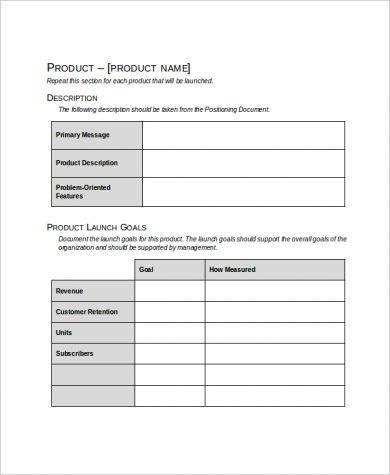
onwe.bioinnovate.co
Details
File Format
PDF
Size: 27 KB
Manufacturing Product Marketing Plan Example
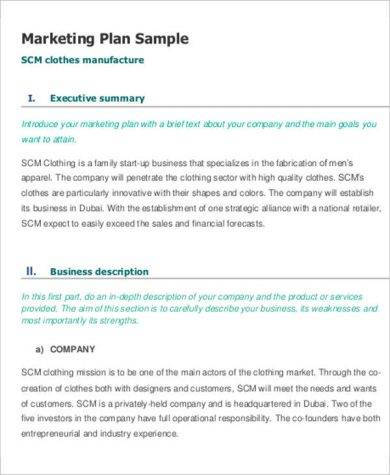
onwe.bioinnovate.co
Details
File Format
PDF
Size: 50 KB
Product Marketing Launch Plan Example
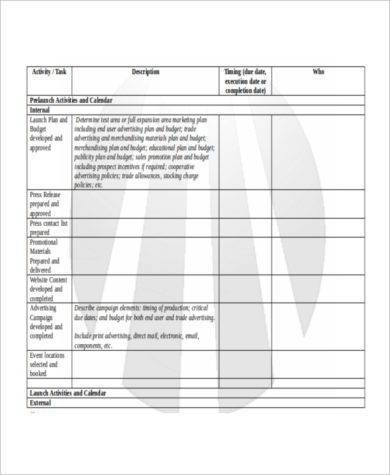
hitdigg.com
Details
File Format
PDF
Size: 41 KB
What Does Product Marketing Do?
While every sector of the company focuses on what’s best for its customers, product marketing puts customers at the front and center of everything it works for. We all know that the primary goals of traditional marketing include building brand awareness, expanding to new markets, and even strategic communication. But when it comes to product marketing, the focus is solely given to the satisfaction of its existing customers. You may also see how to create an executive summary of a marketing plan.
To do this, you need to develop a deeper understanding of who your audience is, what they want, what influences their buying decisions, what problems need to be solved, and what their perceptions are toward your proposed solutions.
Though it may seem as though people come to your store to buy your products, they are actually buying solutions to their problem. With that being said, knowing their problem allows you to develop and promote the best solution to such problem. You may also like digital marketing plan examples.
Effective Ways to Market a Product
Marketing a product works in various ways. Everything from the product’s packaging, features, pricing, and promotion plays a key role in its success. You may not have a billion dollars to throw at your advertising strategies, but you can surely use the principles and techniques that formulate a winning campaign. You may also check out restaurant marketing plan examples.
Here are some awesome secrets in product marketing you might want to apply:
1. Tell a story.
Again, it’s time you start eliminating those self-centered thoughts and realize that no one wants your products, they just need a solution to their problem.
So instead of concentrating on benefits, features, and facts, the real game changer is telling a (true) story. Stimulating one’s emotions through storytelling can help make your advertisement memorable. A real-life story can easily capture a viewer’s attention, and keep them connected to your product and brand. You might be interested in event marketing plan examples.
2. Don’t work against your image.
Many product marketing campaigns fail not because their products aren’t good, but because the company responsible for producing these products forget how important consumer perception is. For instance, in the 1980s, the candy brand Life Savers marketed their own soda line in an attempt to widen their audience. Although the soda did pretty well in taste tests, it tanked among buying customers.
People assumed that the drink was purely made up of liquid candy, and it comes as no surprise considering the image the brand has already established for itself.
3. Do what your competitors won’t dare to do.
Taking risks in a fast-changing world is a bold move. But sometimes, taking the leap can lead to successful outcomes.
Around the 1970s to the 1980s, Nike used a marketing tactic that was sometimes scoffed at in the advertising world: celebrity athlete endorsements. The sports apparel company began signing well-known and up and coming athletes for their product marketing campaign. Instead of playing it safe, Nike decided to try something new despite the high chances of failing. You may also see personal marketing plan examples.
4. Market to existing customers.
When brands like Pepsi and Coke began to dominate the beverage market in the early 1990s, there was an alarming decline on milk consumption in California.
Apparently, there was nothing exciting about milk that made people want to buy them. This forced the California Advisory Board to work with GS&P to find how they could increase milk sales. This led to the creation of the popular Got Milk? campaign which helped increase the demand among loyal fans. You may also like making marketing plans that work.
5. Introduce new products with new brand names.
You may not know it, but some of the biggest companies in the world carry a series of brands under their wing that each focuses on a niche market.
Let’s take Procter & Gamble as an example. P&G has generated more than a billion dollars from their brands Ariel, Crest, Gillette, Olay, Head & Shoulders, Oral-B, Pampers, Pantene, and Tide, just to name a few. P&G has a total of 55 product lines that cater to a variety of customer needs and demands. You may also check out integrated marketing plan examples.
Product Marketing Plan Guidelines Example
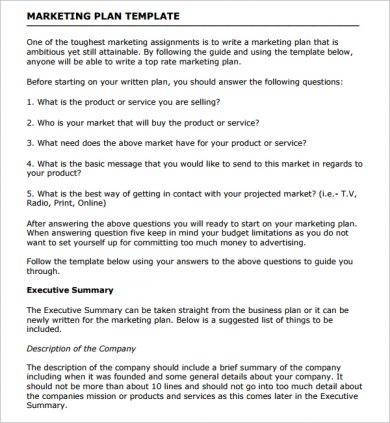
onwe.bioinnovate.co
Details
File Format
PDF
Size: 90 KB
Product Marketing Plan Outline Example
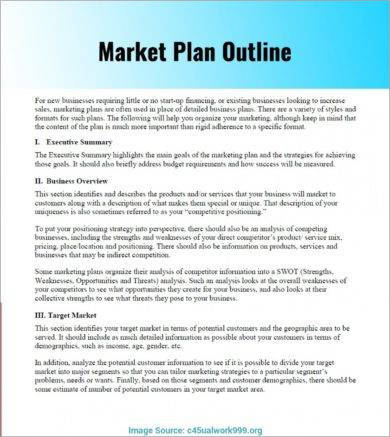
onwe.bioinnovate.co
Details
File Format
PDF
Size: 246 KB
Product Marketing Plan Proposal Example
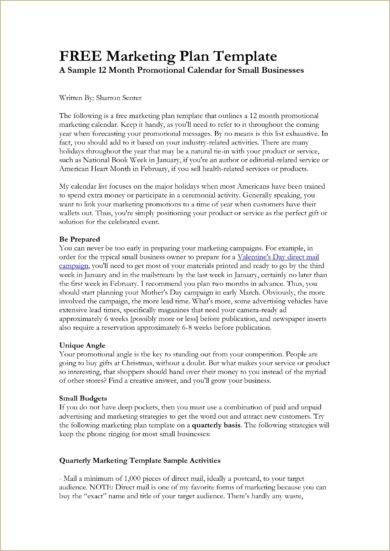
onwe.bioinnovate.co
Details
File Format
PDF
Size: 286 KB
Popular Brands with Successful Product Marketing Plans
Companies that market their products beyond consumer expectations are usually the most successful. Not only because they influenced the growth of the brand, but also because of how they managed to speak the universal truth that customers continue to remember years after these campaigns were first launched. You may also see how to write a marketing plan for a business.
The following are examples of some of the best product advertisements of all time, along with the lessons we can learn from them:
1. Coca-Cola: Share a Coke
While everyone was too busy trying to appeal to the masses, Coca-Cola focused on individuality—simply by putting a person’s name on each of their bottles.
The #ShareACoke campaign was a huge hit on social media, with everyone posting photos of a coke bottle with their names on it.
The campaign began in Australia in 2011 when the company decided to print personalized bottles with 150 of the most popular names around the country. The company even allowed customers to order custom bottles from their website with requests that include nicknames and college logos. For some wild reason, many people were entranced by the campaign despite knowing that the personalized item was only temporary. You may also like marketing strategy plan examples.
2. Volkswagen: Think Small
Volkswagen’s product marketing campaign focused on one vital question: how can you change one’s perception not only about a product but also about an entire group of people?
The company’s Think Small campaign wanted to prove something to its foreign audience. You see, Americans were stern on buying big American cars, and 15 years after WWII ended, there was still no interest in small German cars due to the circumstance at hand. You may also check out apartment marketing plan examples.
So rather than trying to be something they’re not, Volkswagen decided to swing it with an ad campaign that screams, “You think I’m small? Yeah, I am.” Consumers immediately caught on to the campaign because of its sincerity and honesty.
3. Apple: Get a Mac
Apple has always been pretty good with their product marketing campaigns, but the Mac vs. PC debate has to be one of their most successful campaigns of all time. It was simple, clever, and most of all—brutally honest. The commercial tells viewers everything they need to know about a Mac in a witty yet creative way. This created a connection between the brand and its consumers, allowing people to see themselves using it.
4. Wendy’s: Where’s the Beef?
Wendy’s had the guts to take on their competitors without going as far as name dropping their targets. Instead, the company pointed out the lack of beef in competitor’s burgers through a Where’s the Beef? marketing campaign. Even though the campaign only ran for a year, the catchphrase managed to leave a mark in the minds of consumers. You might be interested in advertising plan examples.
5. Procter & Gamble: Thank You, Mom
Probably one of the most sentimental product marketing campaigns to ever hit the small screen, Procter & Gamble developed a commercial that gave viewers a glimpse of the love and sacrifice that mothers of Olympic athletes had to endure. It was an ad that pulled at the heartstrings of viewers through its timely and relatable approach that consumers are sure to remember for a very long time. You may also see email marketing plan examples.
Product Marketing Plan Template
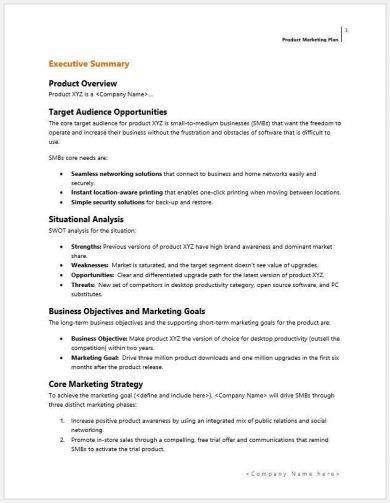
clickstarters.com
Details
File Format
PDF
Size: 73 KB
Simple Product Marketing Plan Example
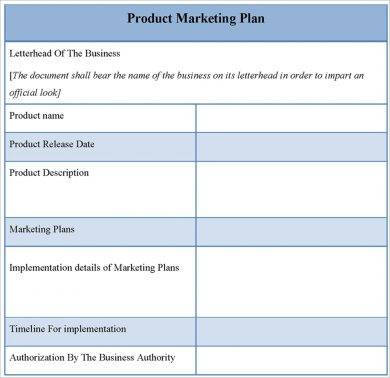
vinotique.com
Details
File Format
PDF
Size: 43 KB
Small Business Product Marketing Plan Example
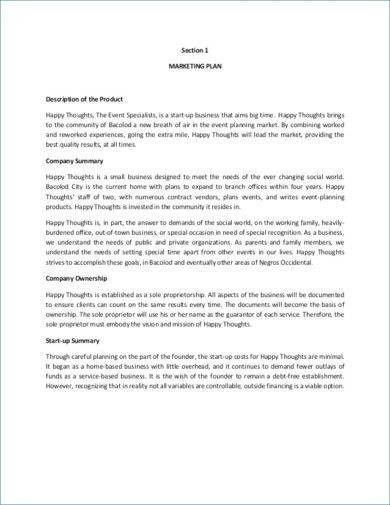
spartagen.org
Details
File Format
PDF
Size: 70 KB
How to Create a Product Marketing Plan
A written marketing plan can function as a guide for you to follow in order to accomplish your goals for product marketing. The business owner or marketing manager is usually held responsible for putting together a plan, but regular employees, such as a finance manager or an operations manager, can also provide valuable input for the plan to work.
To help you through this process, here’s a step-by-step guide for you to follow:
1. Define your product and sales goals.
Create a description for the product you’re marketing. But as opposed to focusing on its mere features (size, color, style), describe how the product may benefit its users. You should also identify your desired professional goals for the product, along with a deadline or time frame for the specified goal.
2. Formulate a market analysis.
Create a SWOT analysis for your product marketing plan. This includes the strengths and weaknesses that exist within your company and the product, as well as the opportunities and threats in the external environment that may impact your product sales. This analysis will help you determine the difference of your product from its competition, allowing you to make the most out of this uniqueness by developing a distinct marketing message.
3. Describe your target market.
Your target market is composed of the individuals or groups that use your product or who would likely benefit from your products the most. In this section of your plan, you must provide specific information about your market segment. This includes their age, gender, geographic location, household income, and work situation. You may also see daily plan examples.
4. Develop marketing strategies.
Now that you have established your marketing goals and identified your target market, you can now formulate your strategies. Marketing strategies involve the specific steps you’re willing to take in order to promote the product. This should describe how the product is promoted, distributed, priced, and packaged before it reaches the hands of its consumers.
5. Determine the marketing budget.
Naturally, you won’t be able to launch a campaign without a budget to start with. Budgets are usually defined during the start of the year, so with the money that has been allocated to your department, decide how much of it will be used to market and promote the given product. This will help you determine which marketing strategies may be executed according to the allotted budget.
It’s hard to accomplish anything without a general plan in place. Plans help us make strategic decisions based on market research and analysis. And if a company decides to introduce a new product to its consumer market, they must first develop a plan to minimize the likelihood of errors and poor decisions. As the fast-changing market continues to grow, so does the strategies to which these products are marketed to the public.

